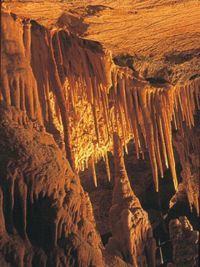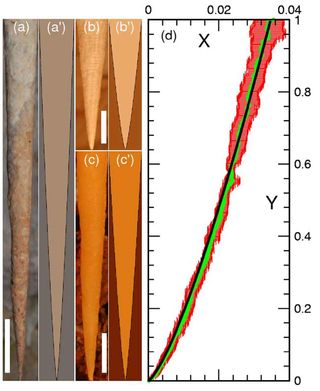Stalactite Surprise: All Have Same Shape

Plato said most people do not see the underlying reality around them. Instead what they see are mere representations, like shadows on the wall of a cave.
Scientists in Arizona have taken this allegory to heart and have gone searching for the underlying reality of stalactites - natural rock formations that hang from cave ceilings like giant rocky icicles.
"Any real stalactite will have bumps and wiggles," said Raymond Goldstein of the University of Arizona. "But we now understand the basic carrot-like shape."
Goldstein and his collaborators have devised a mathematical model that describes the general shape. They call this the "Platonic form" of stalactites. What is striking is that the model only depends on size. All stalactites have the same basic shape.
"If I tell you something is a circle or a square, all I have to tell you is the size for you to draw it," Goldstein told LiveScience.

Stalactites are similar in that you could correctly guess the shape even if the only thing you knew was the ratio between the length and the width. To envision this, imagine taking the outer shells of a bunch of stalactites and shrinking or expanding them to the same size, they would stack neatly into each other like paper cups.
The formula that describes stalactites is complicated. "It is a completely new mathematical shape as far as we know," Goldstein said.
Sign up for the Live Science daily newsletter now
Get the world’s most fascinating discoveries delivered straight to your inbox.
Drip, drip
Stalactites grow where water containing carbon dioxide and calcium carbonate seeps into an underground cave. As the water drips from the ceiling, the carbon dioxide escapes in "a gentle version of what happens when you open a soda," Goldstein explained.
The loss of the carbon dioxide changes the acidity, or pH of the water, which causes the calcium carbonate to deposit on the rock surface.
Although this chemistry had been known for some time, Goldstein's team was able to incorporate the fluid dynamics of thin films to arrive at a complete model. Generally speaking, the stalactite growth is influenced by the fact that water droplets will form at the bottom tip of the hanging rock.
"You grow faster near the tip because there's more water there," Goldstein said. "The stalactite gets longer faster than it gets wider."
On average, the length of a stalactite increases at a rate of a centimeter a century. When the scientists simulated the process on a computer, they found they got the same intrinsic shape no matter the drip rate or carbonate concentration that they used.
To test their model, the researchers went to Kartchner Caverns State Park, in nearby Benson, Arizona, and took pictures of 20 different stalactites.
Tricky measuring
Because the formations are fragile, the team could not go up and put a ruler next to each one. Instead, they shined two laser beams of a fixed separation on each stalactite, which gave them a scale for figuring out the dimensions in their images.
The results, which will be published in an upcoming issue of the Physical Review Letters, showed that the real stalactites matched the Platonic ideal to within five percent.
Some of the observed deviations are due to regular ripples that Goldstein thinks are similar to ripples seen on icicles.
"I don't think it is an accident that icicles look like stalactites," he said.












